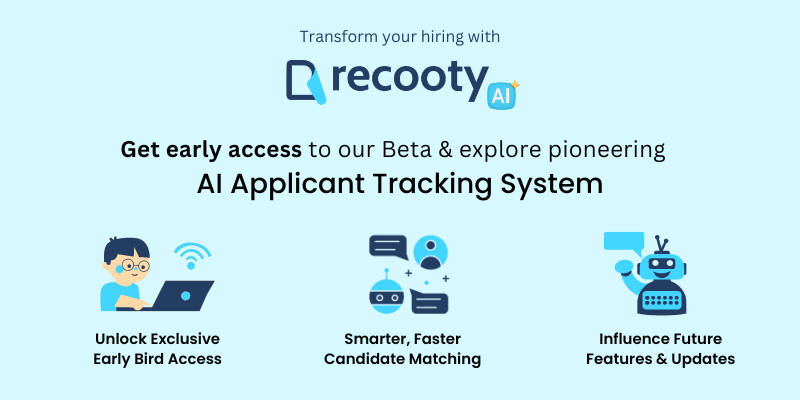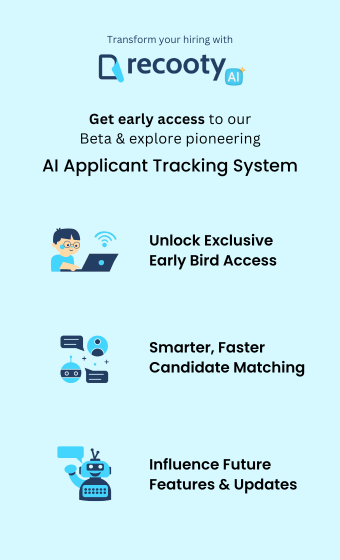
Candidate sourcing is the foundational step to building a team of talented individuals who will lead your startup to success. A process that starts with finding, attracting, and engaging with a wide pool of candidates, sourcing increases your chances of securing the right hire.
If you’re trying to source candidates for your startup and about to enter the competitive job market, it’s crucial to be prepared with innovative candidate-sourcing strategies.
Your sourced candidates will enter your talent pipeline, making you ready for current and future hiring needs. Without these strategies, you risk hiring the wrong candidate and wasting resources, which could negatively impact your company in the long run.
To avoid this and source the right candidate for your talent pipeline, read this post as it covers everything you need to know, including 7 innovative strategies to source the best candidates for your startup.
So, without further delay, let’s get started!
What is Candidate Sourcing?
Candidate sourcing or talent sourcing is simply a process to find qualified talent with a proactive approach. When practicing this, your team connects with potential candidates with the purpose of moving them into the talent pipeline to fill present and future roles. As per a study, approx. 90% of people in the job market are ready to learn about new opportunities. While employees often show interest in positions relevant to them, only around 36% of them actively look for a new job.
Sourcing generally includes practices like:
- Gathering resumes, work samples, portfolios, and other valuable candidate info.
- Building an employer brand to attract candidates through outreach campaigns.
- Pre-vetting candidates whose skills match the job’s desired requirement.
- Get in touch with candidates to establish relationships and notify them of job openings.
- Sustaining continual relationships with the candidates.
All in all, this process is a lot more effective compared to posting jobs and waiting for the candidates to apply.
Talent Pool vs. Talent Pipeline
You might be wondering – What exactly is the difference between a Talent Pool & a Talent Pipeline? Here’s the answer:
A talent pool has candidates who are not screened whereas a talent pipeline consists of all the screened candidates who possess the required qualities which makes them considerable for the position.
Your talent pool will have candidates’ information coming from multiple sources including resumes that were submitted for past roles, applicants you’ve met at the job fairs, and information from other ways.
Later when you start screening the pack and eliminating unqualified applicants, you will move the selected candidates to the talent pipeline. It plays an important role in letting you efficiently target the ideal candidates.
7 Candidate Sourcing Strategies for Startups
To find the candidate your team deserves, these strategies will assist you immensely and make the search process a lot easier:
1. Keep in sync with the hiring manager while conducting the candidate sourcing process
As a recruiter, making sure that your hiring manager on what a strong candidate looks like is crucial. This practice should be done early and from time to time. Plus it’s among the best ways of candidate sourcing.
To improve your communication with the hiring manager, here are a few effective steps:
- As soon as you get a job requisition, arrange a quick meeting to discuss the role and identify both necessary and desirable requirements.
- Request your hiring manager to assist you in listing down the job boards where it’s likely your ideal candidates are present and list the role-specific keywords for your search.
- Do a couple of searches together to explore why a particular candidate might or might not be a great fit.
- Assess the entire talent pool and decide whether requirements should be tightened or relaxed to attract the right amount of candidates.
Remember, to be in the ongoing loop with your manager during the entire process to ensure the candidates’ quality and quantity are on point along with making refinements as and when required.
2. Leverage ATS for Sourcing Candidates is Ideal
When you’re investing your time in sourcing qualified candidates, you will not only get a new employee but also the candidates who are eligible to be hired for future roles. However, re-engaging candidates remains an untapped opportunity for most companies in the market.
Almost all companies believe re-engaging past applicants will allow them to create a talent community and help strengthen their employer brand, still only about 50% of them are practicing this process.
It’s important to not let the efforts of your team go in vain. Always try starting the candidate search by considering the candidates that already were a potential fit for your company. And to do that, an engagement plan is always required.
How to engage candidates?
Candidate engagement is an impeccable talent recruitment approach, helping you build an employer brand that won’t fail to attract future talent. Furthermore, it opens the gate for past candidates who weren’t hired in the past but are promising fits for the future.
Not planning engagement strategies in advance might pose a risk of losing candidates who’ve expressed their interest in the past. Additionally, it’s crucial to archive the past candidates correctly to make sure you find them on time and also secure a smooth experience for the ones who decide to re-engage in the future.
Here are a few ways to take advantage of your past hiring efforts to get talent for the future:
a) Review why candidates weren’t selected
Before you start re-engaging past talent, know why they didn’t make it to the position. You need to keep tabs on questions like:
- Is the job already filled?
- Are they a potential fit for a role that you don’t have?
- Are they underqualified at the moment but have good potential?
To track all these, an ATS with a comprehensive candidate dashboard like Recooty can come in handy.
b) Deliver Feedback
When you deliver constructive feedback to candidates, they are 4 times more likely to consider your offer but close to half of candidates don’t receive feedback from employers.
c) Take Follow up
The majority of candidates indicated that if a company fails to notify them of their application status, it would deter them from applying to relevant job roles there.
3. Opt for Multiple Online Channels for Candidate Sourcing
Recruiters generally have their preferred channels to search for candidates. 52% of recruiters indicate that they reach out to their professional network and 28% of other recruiters choose LinkedIn. But there’s no reason to stop right there!
These common channels are good however it’s crucial to include some occasionally used in your list. For example, on less conventional websites, candidates are more likely to respond. Furthermore, you might capture distinctive info on such channels that you can leverage for personalized outreach.
But how would you know where to look? Once you understand the candidates you want to target, you will get the answer naturally. For instance, you can go for Dice to find tech talent, you can find them on Dice, and for remote workers, you can turn to WeWorkRemotely.
If you’re new to sourcing, asking the following questions to your team will help you decide on where to go:
- As a professional who has worked in this field for a long time, where will you start looking for candidates for this role?
- In which places does this community gather?
- Which other companies focus on equivalent tech/product/services?
- Are there different titles for this specific position? What are those?
4. Consider Offline Methods of Recruiting
Evidently, online methods promise amplified candidate reach and engagement. However, offline methods haven’t become obsolete and are still very powerful options to search for qualified individuals. These methods involve practices like meeting potential employees in person at avenues like job fairs, industry-specific conferences, or arranging your own meetups.
This approach gives you a fair chance to stand out as an employer and increases the likelihood of candidates responding given that you’ve had a conversation with them. You can also ask your teammates who are attending these events to spot potential candidates as well.
5. Employees’ Networks are Great for Sourcing Candidates
Startups can exponentially increase their talent pool via their existing teammates’ network. To access untapped talent, your employees can help a lot as they are already familiar with them. You can arrange group sessions for candidate sourcing where you can ask your team to suggest candidates they might know for a specific role.
In addition, Leverage social platforms like Facebook with your team. Encourage your teammates to search for candidates on Facebook, which will display candidates based on their social graph and help you find those you might have otherwise missed. Similarly, you can also use a more relevant place to find great candidates (e.g., LinkedIn) as well.
Once you find an ideal candidate from your employees’ network, you can ask your employees for a warm introduction, instead of reaching them through a cold email. This improves candidate response rates.
6. Make Excellent Outreach Messages for Candidate Sourcing
Your sourcing efforts may lead nowhere if the sourced candidates won’t engage with you. For this, outreach messages can come in handy.
To make your messaging perfect, some common practices include – bringing personalizing to your messages based on candidates’ requirements & preferences. It should be similar to the way you engage your customers.
Some best practices to consider when designing outreach messages:
- Write an engaging subject line that grabs their attention and makes them read your message.
- Bring personalization to messages using relevant candidate info.
- Offer a quick snapshot of your role and organization.
- Explain what essential part they will play in your company’s growth story.
Before you start creating an impactful outreach message, it’s crucial to understand your audience. For example, if a company is selling a compelling product, 78% of sales professionals indicated they would accept less money to work in that company. Likewise for 66% of healthcare professionals, if a company has a favorable culture, they would happily accept less money to work there.
Additionally, you need to improve your response rates by highlighting things important for your candidates. For this, just provide essential information only to spark their interest, without providing too much information.
Your recent hires can help a lot in preparing these messages. Ask for their feedback on your messages, leverage that feedback for testing diverse messaging types, and finally enhance your response rates
7. A Strong Employer Brand is Essential
For a startup, creating an employer brand is absolutely necessary. It’s because if the candidates aren’t aware of what the startup does and what it’s like to work there, they are less likely to respond.
On the other hand, if a company has a solid image as an employer and is offering a job, as many as 92% of candidates indicated that they would think about leaving their current job to accept the offer.
Here are some ways to build a solid employer brand:
Ask your employees to share their experience
Team up with your marketing team
Give responses to reviews
Encourage your current teammates to share their genuine experiences about working at your startup on diverse online (LinkedIn & Glassdoor) and offline channels (conferences & meetups). This is a very effective way to increase awareness of your employer brand.
When your potential candidates hear true stories, directly from your teammates, it creates authenticity and trust, making potential candidates more inclined to engage and apply. It humanizes the company culture, offering insight into the employee experience and fostering a stronger connection with prospective hires.
There’s nothing better than the synergetic efforts of the hiring and marketing team for building a solid employer brand. The reason is simple – a lot of methods used by the marketing team to promote your company brand are the exact ones that are required to spread your employer brand. A team-up would make the process of your employer brand promotion more fruitful.
More than 60% of candidates check a company’s reviews before deciding whether or not to apply. Stay active on platforms like Glassdoor to check for reviews and share responses to communicate that you appreciate feedback and are willing to take action when needed. This is beneficial both for generating goodwill and to make your employees feel heard.
To learn more about employer branding in-depth, read our complete employer branding guide.
As the competition for top talent is high, it’s important to be strategic with your approach to win candidates for your startup. In this situation, you need to proactively find the group of candidates you need to make your venture successful. The strategies we’ve listed here will help you to source candidates that will fill your talent pipeline so you can hire your next best teammate effortlessly.
Frequently asked questions
There are many ways! Utilize online job boards, tap into your network, attend industry events, and leverage employee referrals.
Pro Tip: Using an Applicant Tracking System (ATS) like Recooty can streamline candidate sourcing by centralizing applications and simplifying communication.
Most job boards and your ATS will allow you to tag how you found the candidate (social media, referral, etc.). This helps measure what sourcing strategies are most effective.
Recooty can help: Track source channels within the platform and see which ones deliver the best talent pool for your startup.
Focus on creating a clear job description highlighting the role’s requirements and your company culture. Conduct thorough interviews that assess skills and fit.
Pro Tip: An ATS like Recooty can help with interview scheduling, scorecards, and communication, ensuring a smooth hiring process.
Look beyond traditional job boards. Network with industry professionals online and offline, utilize social media platforms like LinkedIn, and consider employee referrals.
Recooty can help: Build a strong employer brand career page with your ATS to attract top talent organically.







